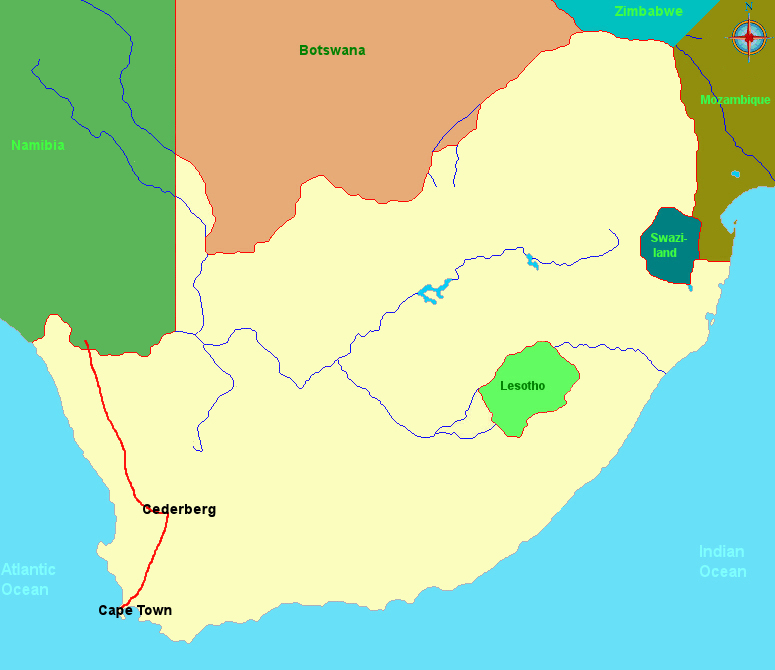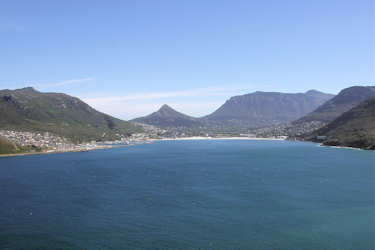South Africa

Historie
The earliest representatives of South Africa's diversity – at least the earliest we can name – were the
San and Khoekhoe peoples (otherwise known individually as the Bushmen and Hottentots;
collectively called the Khoisan). Both were resident in the southern tip of the continent for thousands of
years before its written history began with the arrival of European seafarers.
Their existence was of little import to Jan van Riebeeck and the 90 men who landed with him in 1652 at
the Cape of Good Hope, under instructions by the Dutch East India Company to build a fort and
develop a vegetable garden for the benefit of ships on the Eastern trade route. Later governors of the Cape Colony
encouraged immigration, and in the early 1700s independent farmers called trekboers began to push
north and east. Inevitably, the Khoisan started literally losing ground, in addition to being pressed by difficult
circumstances into service for the colonists.
As a result of developments in Europe, the British took the Cape over from the Dutch in 1795. Seven years later,
the colony was returned to the Dutch government, only to come under British rule again in 1806, recaptured because of
the alliance between Holland and Napoleon.
During the early 1800s, many Dutch settlers departed from the Cape Colony, where they had been subjected to British
control. They migrated to the future Natal, Orange Free State, and Transvaal regions. The Boers founded the
Boer Republics: the South African Republic (now Gauteng, Limpopo, Mpumalanga and North West provinces) and
the Orange Free State.
The Boer Republics successfully resisted British encroachments during the First Boer War (1880–1881) using
guerrilla warfare tactics, which were well suited to local conditions. The British returned with greater numbers,
more experience, and new strategy in the Second Boer War (1899–1902) but suffered heavy casualties through
attrition; in spite of which they were ultimately successful.
Eight years after the end of the Second Boer War and after four years of negotiation, an act of the British
Parliament (South Africa Act 1909) granted nominal independence, while creating the Union of South Africa
on 31 May 1910. The Union was a dominion that included the former territories of the Cape and Natal colonies, as
well as the republics of Orange Free State and Transvaal.
In 1948, the National Party was elected to power. It strengthened the racial segregation begun under Dutch and
British colonial rule. The Nationalist Government classified all peoples into three races and developed rights
and limitations for each. The white minority (less than 20%) controlled the vastly larger black majority. The
legally institutionalised segregation became known as apartheid.
While whites enjoyed the highest standard of living in all of Africa, comparable to First World Western nations,
the black majority remained disadvantaged by almost every standard, including income, education, housing, and
life expectancy.
In 1960, 70 black protesters were killed during a peaceful demonstration in Sharpesville. The African
National Congress (ANC), the principal antiapartheid organization, was banned that year, and in 1964 its leader,
Nelson Mandela, was sentenced to life imprisonment.
Black protests against apartheid grew stronger and more violent. In 1976, an uprising in the black township of
Soweto spread to other black townships and left 600 dead.
Beginning in the 1960s, international opposition to apartheid intensified. The UN imposed sanctions, and many
countries divested their South African holdings.
Apartheid's grip on South Africa began to give way when F. W. de Klerk replaced P. W. Botha as
president in 1989. De Klerk removed the ban on the ANC and released its leader, Nelson Mandela, after 27 years of
imprisonment.
In 1991, a multiracial forum led by de Klerk and Mandela, the Convention for a Democratic South Africa
(CODESA), began working on a new constitution. In 1993, an interim constitution was passed, which dismantled
apartheid and provided for a multiracial democracy with majority rule.
The peaceful transition of South Africa from one of the world's most repressive societies into a democracy is
one of the 20th century's most remarkable success stories. Mandela and de Klerk were jointly awarded the Nobel
Peace Prize in 1993.
Following the election of 27 April 1994, Nelson Mandela was sworn in as President of South Africa.
In 1999, South Africa held its second non-racial elections. The governing ANC increased their majority, putting the party
within one seat of the two-thirds majority that would allow it to alter the constitution. Thabo Mbeki was elected as
the nation's second ethnically Black President.
Following Mbeki's resignation, Kgalema Motlanthe was appointed president by the South African National Assembly on 25
September 2008. The ANC made it clear that Motlanthe would be a "caretaker" president until the election on 22 April 2009,
for which Jacob Zuma was the ANC's presidential candidate. Jacob Zuma was sworn in as president on 9 May 2009.
Following Zuma's resignation, Acting President Cyril Ramaphosa of the ruling African National Congress was elected unopposed as
President of South Africa by the National Assembly on 15 February 2018.
I visited South Africa in oktober 2014.
It was part of my Cape Town - Victoria Falls trip
On that trip i have seen
Cape Town
Cederbergen
Please let me know when you're having questions.
i would be pleased to help you.
Things to do and other tips
